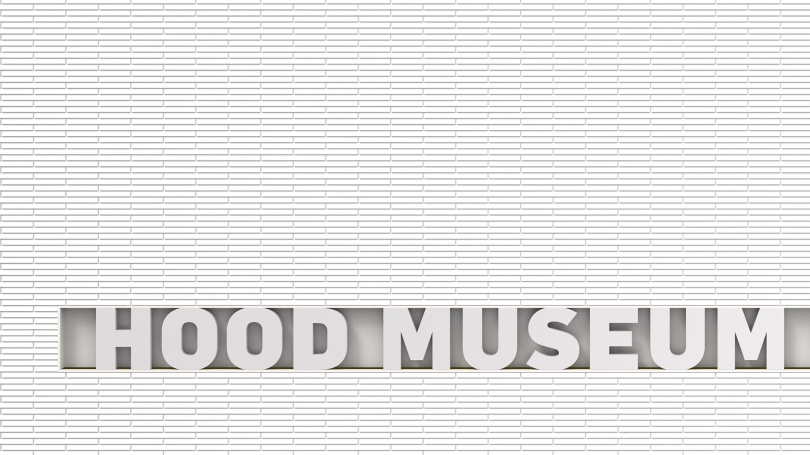Pentagram's Abbot Miller Discusses the Hood's Rebranding with Nils Nadeau, Hood Associate Director, Strategy and External Relations
Nils Nadeau (NN): The Hood has valued its years-long partnership in developing the new museum together with you and architects Tod Williams and Billie Tsien. You worked with that architectural team before, on the award-winning Barnes Foundation. What do you value about that working relationship, and what do you learn from each other that drives the creative process?
Abbott Miller (AM): Tod and Billie’s practice is a partnership with the two of them in constant dialogue with one another. Because of that, there is a space for other creative partners to enter in the conversation. You could say that is a part of a group dynamic, but it’s an animating principle for them, and it’s core to who they are. There is real dialogue, real disagreement, a genuine evolution of thinking that takes place: they are thoughtful, passionate, and genuine, and they like what signage and messaging brings to the visitor’s experience. Some architects are ambivalent about those things, but they really enjoy the conversation.
NN: You wrote in Abbott Miller: Design and Content (Princeton Architectural Press, 2014) that “negotiating the relationship between design and content is the defining dynamic” of your work. Can you describe your approach in the context of your work with the Hood Museum of Art?
AM: That comment relates especially well to the work we do in developing exhibitions and books, but it’s less obvious when you talk about creating a visual identity and signage, because the context has more to do with creating a frame for content. I think a visual identity has a more circumscribed role to play for an institution: it needs to express a personality that is clear and identifiable, without getting in the way of the variety of messages an organization needs to give voice to.
NN: How does the Hood’s new brand extend beyond its word mark to inform its physical, digital, and print presence? What does the brand say about the institution?
AM: With the Hood Museum of Art, the new building sets a tone for everything: the graphic expression supports that. Just like the architecture, the visual brand needs to work whether the imagery is historical or contemporary. The goal is to create a graphic environment (in the website, publications, ads, and in the space of the museum itself) that accommodates the multiple expressions embodied in the collection and in the goals of a teaching museum.
The typographic voice of the identity is modern and confident: it says the institution is on balance about the present and the future. In a historic campus like Dartmouth, there are so many reinforcements of legacy, history, and tradition that it’s important to embrace aspects of contemporary culture. The contrast that happens when you see historic art in a contemporary setting is one of the most powerful “lessons” you can construct for students and visitors.
AM: What I think is particularly strong in this project is the continuity of the Hood Museum of Art signature in its various settings: Tod and Billie really embraced it as an element of the building facade; the lettering creates an emblem that is emphatic and declarative wherever its seen.
NN: Your interdisciplinary understanding of design has also allowed you to work in all kinds of interesting situations, including public and gallery exhibitions. Can you tell us about a recent project and what you got out of it?
AM: I’m working on a project in China right now that is interesting because the cultural contextis less familiar. It is requiring an adaptation to new technological, generational, and visual languages. I love working with art museums, because I feel so connected to their mission, but it’s interesting to have the rug pulled out from under you once in a while. That has happened a couple of times this year when working internationally, but it’s probably a good thing to shake things up!
About Abbott Miller
Abbott Miller was born in Indiana and studied design at the Cooper Union School of Art in New York. In 1989, he founded the multi-disciplinary studio Design/Writing/Research where, in collaboration with Ellen Lupton, he pioneered the concept of “designer as author,” undertaking projects in which content and form are developed in a symbiotic relationship. He joined Pentagram’s New York office as a partner in June 1999.
Abbott’s projects are often concerned with the cultural role of design and the public life of the written word. At Pentagram he leads a team designing books, magazines, catalogs, identities, exhibitions, and creating editorial projects.
Abbott has received numerous design honors, including medals from the Society for Publication Designers and three nominations for National Magazine Awards. In 1994 Abbott—together with Ellen Lupton—was awarded the first annual Chrysler Award for Innovation in Design. He is a member of the Type Directors Club, the Society for Experiential Graphic Design (SEGD) and the Alliance Graphique Internationale (AGI). He teaches in the Graphic Design Department of the Maryland Institute College of Art in Baltimore.
His work and critical writing has appeared in Eye, Print and other publications, and he is the co-author of four books, including the classic Design/Writing/Research: Writing on Graphic Design. A survey of his design work, Abbott Miller: Design and Content, was published by Princeton Architectural Press in 2014.
